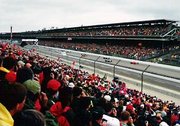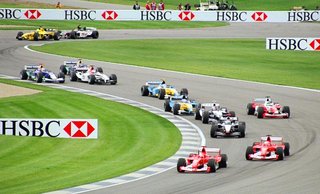Indianapolis Motor Speedway
|
|
| Indianapolis Motor Speedway | |
| Missing image Ims_aerial.jpg Aerial view of Indianapolis Motor Speedway from the southwest | |
| Facility Statistics | |
| Location | 4790 West 16th Street, Speedway, Indiana, 46222 |
| Capacity | 300,000+ |
| Owner | Hulman and Co. |
| Major Races | |
| 2005 Indy Racing League | Indianapolis 500 |
| 2005 Formula One | United States Grand Prix |
| 2005 NASCAR Nextel Cup | Allstate 400 at The Brickyard |
| Dimensions | |
| Shape | Flat oval |
| Distance | 4.0 km (2.5 miles) |
| Banking/Turns | 9° |
| Banking/Straights | 0° |
Indianapolis Motor Speedway, located in Speedway, Indiana (a separate city completely surrounded by Indianapolis) in the United States, is the second-oldest surviving auto racing track in the world (after The Milwaukee Mile), having existed since 1908. The track is a realtively flat two and a half mile oval, almost rectangular in shape. It has a spectator capacity of over 300,000, the largest sporting facility in the United States. It has been designated a National Historic Landmark.
| Contents |
Early History: tragedy begets "The Brickyard"
Carl_G._Fisher_loc_image.jpg
Indianapolis_Motor_Speedway_-_loc.jpg
When the first race took place in August, 1909, the celebration quickly turned into a disaster due to the surface of crushed stone and tar. There were terrible injuries to the race car drivers and spectators. Cars caught fire, there were deaths, and the race was halted and canceled when only halfway completed.
Following an initiative by automotive parts and highway pioneer Carl G. Fisher, an Indiana native who was both a former race car driver and one of the principal investors, the safety concerns for race drivers and spectators eventually led to a substantial additional expenditure to pave the track surface with 3.2 million bricks, and gave the track its popular nickname, "The Brickyard".
Attracting 80,000 spectators to the first 500 miles (800 km) race on Memorial Day May 30, 1911, at $1 admission, the Speedway reopened and hosted the first in a long line of five hundred mile (800 km) races known as the Indianapolis 500. Ray Harroun won at the brisk average speed of 74.602 mph (120.060 km/h). A new tradition had been established.
1912-1939
A classic race followed in 1912 when Ralph DePalma lost a five lap lead with five laps to go when his car broke down. As his car was being pushed around the circuit, Joe Dawson made up the deficit to win the race. These races gave Indy a worldwide reputation and international drivers began to enter. Three of the next four winners were Europeans, with DePalma being the exception.
The race was interrupted for two years by World War I, when Indy served as a military hub for repairs. When racing resumed, speeds increased and by 1925, when Peter DePaolo won, the best cars were averaging 100 mph (160 km/h) for the race. By the early 1930s, however, the increasing speeds began to make the track increasingly dangerous, and in the period 1931-1935 there were 15 fatalities. This forced another repavement, with tarmac replacing the bricks in parts of the track. The danger of the track during this period, however, didn't stop Louis Meyer or Wilbur Shaw from becoming three-time winners, with Shaw also being the first back-to-back winner (1939-1940).
The 1940s
At the beginning of the 1940s, the track required further improvement. In 1941, half of "Gasoline Alley," the garage area, burned down before the race. When US involvement in World War II cancelled the race for four years, the track was abandoned and was in bad shape when drivers returned in 1946. The track was sold to Tony Hulman at that time, and major renovations were made. The stands were remodelled, suites and museums were added, and many other additions helped bring back Indy's reputation as a great track.
Several drivers helped bring back its reputation as well, including three-time winner Mauri Rose and Bill Vukovich. In the 1950s, cars were going 150 mph (240 km/h) around the Speedway, helping to draw more and more fans. The track’s reputation improved so much the Indy 500 became part of the Formula One World Championship for 11 years (1950-1960), even though none of the Indy drivers raced in Formula One and only Ferrari's Alberto Ascari of the F1 drivers at the time raced in the 500.
Asphalt

After the last Indy 500 to be part of the World Championship, the track became completely asphalt, with the exception of a distinct three-foot-wide line of bricks at the start/finish line -- turning the "Brickyard" into the "Yard of Bricks." Ironically, a wave of F1 drivers went to the Speedway in the 1960s, and the rear-engine revolution that was started in F1 by the Cooper team changed the face of the 500 as well; since Jim Clark's win in 1965, every winner has driven a rear-engined car. Graham Hill won the following year at his first attempt. There were enough Americans to compete with them, with A.J. Foyt, Mario Andretti, and Bobby and Al Unser leading the charge in the 1960s and 1970s. In the 1970s the Speedway became more than a race track, as it began to feature a pair of golf courses and a hotel.
From 1970 to 1981, Indianapolis had a twin out in the city of Ontario, California by the name of the Ontario Motor Speedway, this track was known as the "Indianapolis of the West" and the home of the California 500; but was a financial failure due to bad managment and not holding enough races on the racetrack.
The 1980s brought a new generation of speedsters, led by Rick Mears (who recorded the first 200 mph (320 km/h) race lap in 1982), Danny Sullivan, and Bobby Rahal. In 1989, F1 veteran Emerson Fittipaldi astounded drivers and fans when winning and recording the first 220 mph (350 km/h) race lap in the process. Indy had never even seen a 210 mph (340 km/h) lap during a race before then. Arie Luyendyk won the following year, and did so in the fastest 500 ever, with an average lap of 185.981 mph (299.307 km/h).
NASCAR, Formula One, IROC, PGA golf at Indy
Up until the 1990s, the 500 was the only racing done on the Brickyard. However, when Tony George (Hulman's grandson) inherited the track, he brought more racing to the Speedway, with the NASCAR Allstate 400 at The Brickyard and an International Race Of Champions (IROC) race. The golf course was changed from 27 holes (nine inside, eighteen outside) to a new 18-hole layout designed by legendary golf architect Pete Dye, with a Champions Tour (formerly the Senior PGA TOUR) event hosted there. The 500 itself got a new look in 1996 when it became an event of George's Indy Racing League, formed as a rival to the Champ Car World Series.
In 1998, George arranged for Formula One to return to the US for the first time since 1991. Two years of renovation and new construction for an Indy-based road course led to the first US Grand Prix there in 2000, a race which was a great success. The 2001 event's success (185,000 fans were reported in attendance) was even more important with the race being the first major international sporting event in the States after 9/11. The event's popularity is expected to potentially bring an American driver back to Formula One for the first time since 1993, though judging by the performance of foreign drivers in American domestic open-wheeler series it is unclear whether any of the current crop of American drivers would be competitive.
The Grand Prix road course, unlike the oval, is raced in a clockwise direction. This makes the US Grand Prix highly unusual in North American motorsports; however, it follows the general practice of Formula One, in which the vast majority of circuits (including the F1 circuit in Montreal, but not the F1 circuit in São Paulo) run clockwise. In 2005, only six cars, all with Bridgestone tires started the Unites States Grand Prix due to safety concerns involving Michelin tires. The outrage of this event put the future of Formula 1 at Indianapolis in doubt.
In 2003, the Infiniti Pro Series, a "minor league" series to the IRL, made history with the first May race other than the 500, the Futaba Freedom 100, which has been moved from the final qualifying weekend to the final practice on Friday before the 500. The IROC race was also dropped after 2003 to reflect its new television contract.
See also: List of NASCAR race tracks, List of Formula One circuits
2005 races
- Indy Racing League IndyCar Series - Indianapolis 500
- NASCAR Nextel Cup - Allstate 400 at The Brickyard
- Formula One - United States Grand Prix
- Porsche Michelin Super Cup Support Race
- Formula BMW USA Support Race
- Indy Racing League Menards Infiniti Pro Series - Liberty Challenge
Records
Indy_Pagoda.JPG
IMS_HOF_Museum.jpg
- Indianapolis 500 Qualifying (single lap): Arie Luyendyk, 237.498 mph, May 12, 1996.
- Indianapolis 500 Qualifying (four lap average): Arie Luyendyk, 236.986 mph, May 12, 1996.
- Indianapolis 500 Race average: Arie Luyendyk, 185.961 mph, May 27, 1990.
- NASCAR Qualifying: Casey Mears, 186.293, August 7, 2004.
- NASCAR Race average: Bobby Labonte, 155.912 mph, August 5, 2000.
Dimensions (Standard Oval Layout)
- Long straightaways: 2 × 5/8 mile (1.0 km)
- Short straightaways: 2 × 1/8 mile (0.20 km)
- Turns: 4 × 1/4 mile (0.40 km)
- Banking: 9°12'
- Total distance: 2.5 miles (4.0 km)
- Track width: 50 feet
- Overall length: 0.94 miles (1.52 km)
- Overall width: 0.44 miles (0.71 km)
See also
External links
- Indianapolis Motor Speedway Official Site (http://www.indianapolismotorspeedway.com)
Template:Nextel Cup Seriesit:Indianapolis Motor Speedway
ja:インディアナポリス・モーター・スピードウェイ

